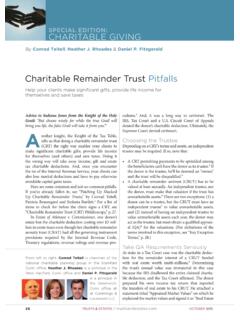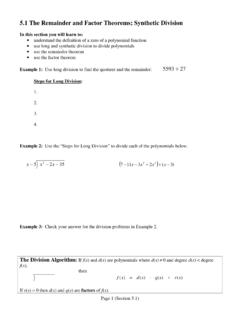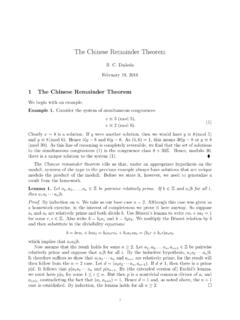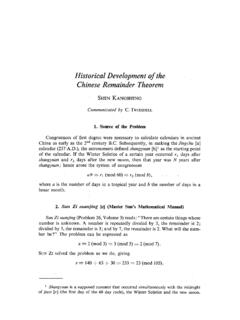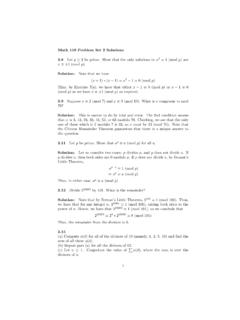Transcription of Termination of Charitable Remainder Trusts - cl-law.com
1 From far left: Conrad Teitell is chairman of the national Charitable planning group, Heather J. Rhoades is a principal and Margaret E. St. John is an associate, all in the Stamford, Conn. office of Cummings & Lockwood LLCK enny Rogers could well have been singing about Charitable Remainder Trusts (CRTs). Donors who create inter vivos CRTs want to: (1) provide life income for themselves (and sometimes also for a survivor); and (2) make a significant gift to charity on the CRT s tax law encourages generosity by giving itemizers an income tax Charitable deduction for the value of their Remainder interest.
2 Capital gains are avoided on funding a CRT with appreciated property. Gains are taxable only to the extent that they re deemed distributed to the life beneficiary under the 4-category taxation regime. Almost all life beneficiaries keep their CRTs for their lifetime; they want life income. So, they hold , change is inevitable (except from a vending machine). So, some CRT life beneficiaries fold em and terminate their Trusts early. They donate their remaining life interest to the Charitable Remainder organization (CRO) (the life beneficiary doesn t need the income and wants to benefit the charity right away).
3 Other CRTs are terminated early by dividing the trust s assets between the life beneficiary and the CRO, based on the actuarial values of their respective to fold em, dear readers, is our OpenersDon t pass Go before determining whether the law permits early Termination of the CRT. At common law, by unanimous consent, all the beneficiaries of an irrevocable trust could compel its Termination or Several Internal Revenue Service private letter rulings allow early CRT Termination . One early PLR dealt with the income beneficiaries assignment of their entire remaining life income interests to the The income beneficiaries planned to petition the local court to obtain a declaratory judgment terminating the trust with the direction that the trust funds be distributed directly to the CRO.
4 The IRS ruled in that PLR that the assignment of the income beneficiaries entire income interest to the CRO and the subsequent Termination of the CRT didn t cause the unitrust to fail retroactively as a Charitable Remainder trust within the meaning of section 664 of the Code. The PLR focused on a state law that permitted assignment of the beneficiaries income PLRs dealt with early terminations of CRTs in which the trust assets were divided pro rata between the income beneficiaries and the CROs. The IRS concluded that the early terminations didn t invalidate the Trusts under Internal Revenue Code Section 664.
5 Again, the IRS focused on a state law that allowed the assignment of an income beneficiary s income states require the consent of all the CRT s beneficiaries to terminate the trust . Additionally, the PLRs often recite that the state attorney general approves the early Some CRTs allow the grantor to substitute a CRO for the one named. If so, before the Termination , the income beneficiary may need to prove that the named CRO hasn t been substituted. Assignment to CFOYour client might consider assigning a life income beneficiary s entire remaining interest to a CRO.
6 Why? The income beneficiary may no longer need Termination of Charitable Remainder Trusts You ve got to know when to hold em, know when to fold em. By Conrad Teitell, Heather J. Rhoades & Margaret E. St. JohnOCTOBER 2014 Trusts & ESTATES / 57 SPECIAL EDITION: Charitable GIVINGthe income and want the CRO to benefit immediately. Sometimes, the CRT s value has significantly declined with the potential that continued income payments will exhaust the trust , leaving nothing for the CRO. The tax consequences. When an income beneficiary assigns his entire income interest in a CRT to a CRO, the transaction is deemed a gift of a capital asset to the Itemizers are entitled to an income tax Charitable deduction for the then-value of the capital asset (the income interest).
7 Poi nter. All taxpayers should claim a gift tax Charitable deduction. Generally, a taxpayer can t claim a Charitable deduction for a contribution of an interest in property which consists of less than the taxpayer s entire interest in such property. 6 However, one PLR points out an exception under Treasury Regulations Section (a)(2)(i). A deduction for a contribution of a partial interest in property is allowable when that interest consists of the taxpayer s entire interest in the An income interest in a CRT falls under this exception.
8 The IRS noted in that PLR that because the income beneficiaries donated their entire interests in the trust , they were able to claim a Charitable deduction and a gift tax Charitable deduction under IRC Section 2522. Show me the money. Naturally, once an income beneficiary assigns his interest to the CRO, it will want all of the CRT s Enter the doctrine of merger. Generally, if a trust beneficiary is the owner of all interests in a trust (both the income and Remainder interests), the trust terminates, and the beneficiary has access to the trust principal.
9 If the merger doctrine doesn t apply under governing state law, a court order may be required to terminate the trust . Some states may require the attorney general s involvement in a CRT s early Termination , whether or not a court order is the spendthrift rules. A beneficiary under the trust s terms or as provided by state law (unless negated in the document) may not be able to dispose of his interest. Generally, a spendthrift provision is meant to protect the beneficiary s interest from creditors or to protect the beneficiary from using the trust assets to go off on a folly of his own.
10 Thus, if a CRT has a spendthrift provision, an early Termination may not be possible. However, if the CRT s donor is the income beneficiary, a spendthrift provision won t bar him from assigning his income The IRS is concerned about donors terminating Trusts to circumvent the partial interest rules. If a donor creates a CRT for that reason, he ll be denied an income tax Charitable deduction on an early Termination . Whether he created the trust to avoid the partial interest rules is a question of fact. One major factor the IRS considers is the amount of time that s elapsed since the trust was created.
